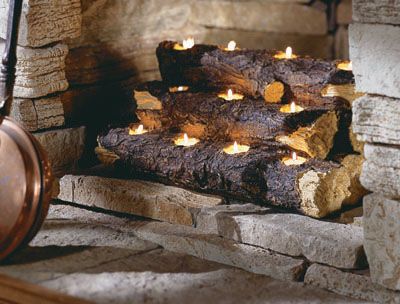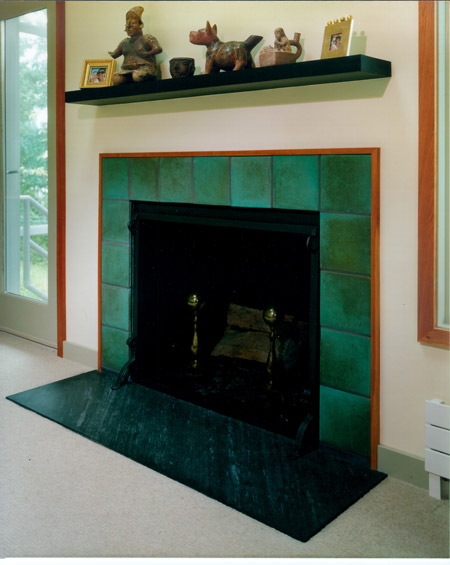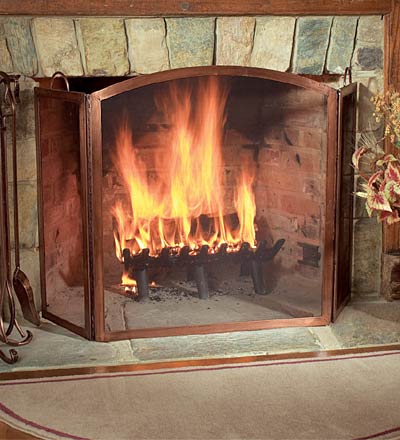Why fireplaces work, and how best to build them, has been a topic of hot debate literally for centuries. From the first stone rings stacked around the campfire, to the modern factory built fireplaces with carefully engineered dimensions, there has been a steady evolution of design parameters to make sure they draw well and cast as much heat as possible. Most of this evolution has been by trial and error, and some designs work much better than others.
Simply put, fireplaces work mainly because hot air rises. When you start a fire, the air inside the chimney becomes warmer and less dense than the air outside the chimney, and consequently it starts to rise. As the warm air rises, cooler air from the room flows into the firebox, fanning the fire, creating more heat in an ongoing cycle. There are also some pressure differentials produced as wind moves across the top of your chimney.

There must be at least 100 reasons why your fireplace may not function properly. We will try to cover some of the basics here starting with the easy obvious solutions and working towards the more arcane. Please bear in mind this is a very simplified list of the more common reasons that fireplaces don't work A true understanding of fireplaces requires extensive knowledge of air flow patterns, pressure differentials, and actual fireplace construction techniques. If the information provided here does not help you solve the problem with your fireplace, consider hiring an experienced, certified chimney sweep in your area. Often the problem is obvious to someone with enough experience once they can actually look over the entire situation.1. Is your damper fully open? Everybody eventually forgets to open the damper. Many dampers also cease to fully open because of water damage or soot buildup behind them on the smoke shelf. A good professional cleaning can usually solve this problem. 2. Is your firewood green or wet from rain or snow? Remember the main reason your fireplace works at all is the heat inside the chimney. If your wood is not dry and well seasoned it makes more smoke than heat and there simply may not be enough heat for the chimney to work properly. 3. Is your chimney dirty? The gradual accumulation of soot can seriously affect the way your chimney performs. Thick layers of soot of course can physically restrict the flue so there is no longer enough free area to vent the fireplace properly, (see problem 5) but as little as a 1/4" to 1/2" inch buildup can make more difference than you might think. Consider that a 1/2" buildup will restrict the air flow by 17% for a typical masonry fireplace chimney, and by a whopping 30% for the average prefab. Birds and small animals also think your chimney looks like a hollow tree in which to set up housekeeping. Sweeps often find chimneys literally packed full of leaves, twigs and baby animals. The solution of course is a good cleaning and a chimney cap. 4. Is your chimney tall enough? To function properly, the chimney should be at least 10 or 12 feet in overall height. Where it projects above the roof, the chimney should be at least 3 feet tall, and at least 2 feet higher than anything within 10 feet of it-including other buildings, trees, etc. If your fireplace smokes because your chimney is too short, the problem is usually worse when the wind blows.

5. Is your flue large enough for the fireplace opening? There are many variables that can affect this including; overall chimney height, how warm the flue stays, throat configuration, etc., but the basic rule of thumb here is that the area of the fireplace opening can be no more than 10 times the area of the flue (12 times for round flues). An undersized flue simply can't handle the volume of smoke produced, and some of it will spill back into the room. Since there is no practical way to make the flue size larger, the solution may be to make the room opening smaller with metal smoke guards or some creative masonry work. In fact there are now some premanfactured refractory firebox retrofits that work well with a 15 to 1 ratio and deliver twice the heat of conventional fireboxes. 6. Is your chimney on the outside of the house? Remember that warm rising air is the basic engine involved here. If you have a large masonry chimney on the outside of the house, and it's cold outside, the air inside of the chimney will also be very cold, and it will want to fall down the chimney instead of rising. This can even happen a day or two after it's warmed up outside. These chimneys may be hard to start and they may smoke as the fire burns low. To help get the fire started many people light some rolled up newspaper and hold it up near the damper to get that cold plug moving upwards. Keeping a moderate sized but bright, actively flaming fire can also help this situation. 7. Is your home too tight? Fireplaces require large volumes of air to burn. Visualize a 12" x 12" column of air rising up your chimney and exiting the top the entire time your fireplace is working (but don't visualize your heat bill!). This air comes from inside the living area and must somehow be replaced. With modern energy efficiency concerns most houses have been carefully insulated and weather-stripped to keep out the cold drafts, but an undesirable side effect is that there is often nowhere for all that air leaving the chimney to get back in. This can lead to fireplaces that burn sluggishly and smoke. A temporary solution is to open a window to let in a little make up air, preferably on the windward side of the house. It can also lead to very dangerous carbon monoxide buildup if your fireplace and furnace must compete for combustion air, and a permanent solution should be found at once.

8. Your house can also be too loose! A house that leaks too much air to the outside, especially a multistory house that leaks air in the upper levels, can actually set up its own draft or chimney effect strong enough to overpower your fireplace chimney, particularly if the fireplace is located in the basement on a cold exterior wall. Be sure the attic access door is in place and that all upstairs windows are tightly closed. 9. The other 92 reasons your fireplace can smoke have to do mainly with design problems when the fireplace was built. Aside from the chimney being too short, or too small, the chimney can also be too large, too tall, too crooked, etc. ad infinitum! Most of these details are fairly technical in nature, and again a good sweep may be your best bet.

